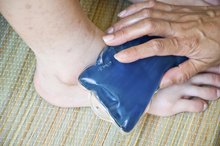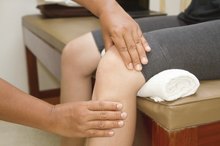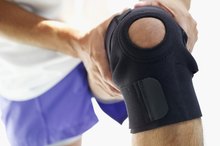Physical Therapy Exercises for a Hyperextended Toe
Hyperextension of your toe can result in a sprain, causing pain and a limp with walking and running 2. You might also experience swelling, decreased range of motion and bruising. Initial treatment consists of rest, ice, compression and elevation; but once pain and swelling subside, you can do range-of-motion and strength and stability exercises. Consult your athletic trainer, medical provider or physical therapist before doing exercises with a hyperextended toe.
If you are experiencing serious medical symptoms, seek emergency treatment immediately.
How It Happens
Hyperextension happens when your toe is extended or pulled back too far. Landing with your weight too far forward on your toes during running or jumping or a direct hit to your toes can lead to hyperextension. Hyperextension usually results in a sprain or tear of the ligaments that stabilize the joints in your toes. In severe cases, you may sustain a dislocation or fracture.
Hyperextension of the big toe and a sprain to the metatarsophalangeal joint is common among football and soccer players who play on artificial turf. That's why this injury is often referred to as “turf toe.”
- Hyperextension happens when your toe is extended or pulled back too far.
- Hyperextension usually results in a sprain or tear of the ligaments that stabilize the joints in your toes.
Regain Range of Motion
Exercises for a Torn Quad
Learn More
Due to the swelling and immobilization of your toe, you may experience joint stiffness and loss of range of motion. In a seated position, you or your physical therapist can hold your toe and gently flex and extend it in the pain-free range -- called passive range of motion. As the pain subsides, you may move your toe without assistance by slowly flexing or curling your toes and then extending your toes. Increase your movements until you regain normal range of motion.
- Due to the swelling and immobilization of your toe, you may experience joint stiffness and loss of range of motion.
- In a seated position, you or your physical therapist can hold your toe and gently flex and extend it in the pain-free range -- called passive range of motion.
Strengthen and Stabilize
In a seated position, slowly pick up marbles from the floor with your toes and place them in a bowl or cup. For further toe strengthening, put a towel under your foot. Curl your toes to pick up the towel. Release the towel and repeat the exercise.
Regain stability with single-leg balance exercises for 30- to 60-second intervals. For further progress, stand on one leg on a wobble board or uneven surface with your eyes closed. Do hip extensions on your non-weight-bearing leg by standing up straight and stretching your leg behind you. Stretch your arms forward for balance.
- In a seated position, slowly pick up marbles from the floor with your toes and place them in a bowl or cup.
Return to Play
How to Increase Flexibility in My Big Toes
Learn More
Before you return to normal activities or your sport, perform functional exercises such as squatting, running, jumping and kicking. If these activities do not cause pain or additional symptoms, your physical therapist may discharge you from physical therapy. Taping your toe or putting stiff orthotics into your shoes may also be necessary to avoid further injury and pain when performing exercises or before participating in sports.
Related Articles
References
- New York University Langone Medical Center: Turf Toe
- Clinical Sports Medicine: Rehabilitation of Ankle and Foot Injuries in Athletes
- Gudavalli MR, Cambron JA, McGregor M, et al. A randomized clinical trial and subgroup analysis to compare flexion-distraction with active exercise for chronic low back pain. Eur Spine J. 2006;15(7):1070–1082. doi:10.1007/s00586-005-0021-8
- Lawrence MA, Chin A, Swanson BT. Biomechanical Comparison of the Reverse Hyperextension Machine and the Hyperextension Exercise. Journal of Strength and Conditioning Research. 2019;33(8):2053-2056. doi:10.1519/jsc.0000000000003146
Writer Bio
Since 2007 Hannah Mich has written e-newsletters and been published in the "Missouri Journal of Health, Physical Education, Recreation and Dance." She has a Bachelor of Science in exercise science from Truman State University and a Master of Education in applied kinesiology from the University of Minnesota.









